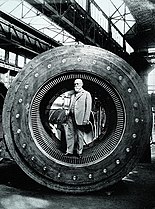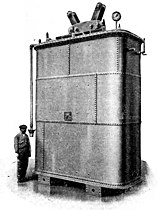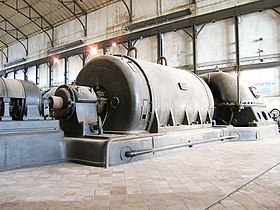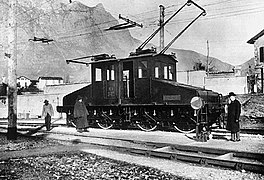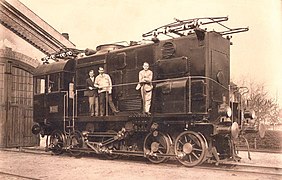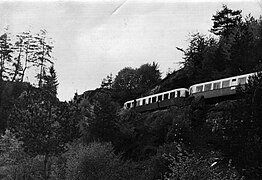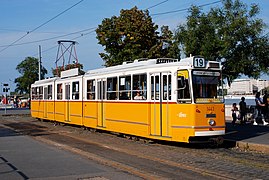Ganz Works
 | |
 The railway factory of the Ganz company (1880—1959: Ganz Wagon- and Machine Factory, 1959—1988: Ganz–MÁVAG Locomotive, Wagon- and Machine Factory) /Budapest, Kőbányai út 19-33./ | |
| Formerly |
|
|---|---|
| Company type |
|
| Industry | Transport Metallurgy |
| Founded | 1844 inBuda,Kingdom of Hungary |
| Founders | Ábrahám Ganz |
| Defunct | 1989 |
| Fate | Sold in 1989 to diverse companies that used the name 'Ganz' for their own enterprises |
| Headquarters | Buda,Hungary |
Area served | Worldwide |
Key people | List |
| Products | Trams Trains Ships Electric generators |
| Owner | Ábrahám Ganzand his family (1845–1947) State of Hungary(1947–1949) |
| Subsidiaries |
|
| Website | ganz-holding.hu |
TheGanz Machinery Works Holdingis aHungarianholding company.Its products are related to rail transport, power generation, and water supply, among other industries.[2]
The originalGanz WorksorGanz(Hungarian:Ganz vállalatokorGanz Művek,Ganz companies,formerlyGanz and Partner Iron Mill and Machine Factory) operated between 1845 and 1949 inBudapest,Hungary. It was named afterÁbrahám Ganz,the founder and manager of the company. Ganz is probably best known for the manufacture oftramcars,but was also a pioneer in the application ofthree-phase alternating current to electric railways.
Ganz also made ships (through itsGanz Danubiusdivision), bridge steel structures (Ganz Acélszerkezet) and high-voltage equipment (Ganz Transelektro). In the early 20th century the company experienced its heyday and became the third-largest industrial enterprise in the Kingdom of Hungary after theManfréd Weiss Steel and Metal Worksand theMÁVAGcompany.
Since 1989, various parts of Ganz have been taken over by other companies.
History
[edit]
The company was founded byÁbrahám Ganzin 1844. He was invited toPest, Hungary,by CountIstván Széchenyiand became the casting master at theRoller Mill Plant(referred to asHengermalomin Hungarian). In 1854 he began manufacturing hard castrailroad wheelsin his own plant founded in 1844. The management of the steam mill paid a share of the profit to Ganz. This enabled him to buy, in 1844, land and a house for 4500 Forints in Víziváros, Buda castle district. Abraham Ganz built his own foundry on this site and started to work there with seven assistants. They made mostly casting products for the needs of the people of the city.[3] In 1845, he bought the neighbouring site and expanded his foundry with a cupola furnace. He gave his brother, Henrik a job as a clerk, because of the growing administration work. He made a profit in the first year, and his factory grew, even though he had not yet engaged in mass production. In 1846, at the third Hungarian Industrywork Exhibition (Magyar Iparmű Kiállítás), he introduced his stoves to the public. He won the silver medal of the exhibition committee and the bronze medaille from Archduke Joseph, Palatine of Hungary.
During theHungarian Revolution of 1848the foundry made ten cannons and many cannonballs for the Hungarian army. Because of this, the Military Court of Austria impeached him. He got seven weeks in prison as penalty, but because of his Swiss citizenship he was acquitted of the charge.[3]

Ganz recognized that, to develop his factory, he had to make products that were mass-produced. In 1846 the Pest-Vác railway line was built. At that time, European foundries made wrought iron rims for spoked wagon wheels by pouring the casts in shapes in sand, and leaving them to cool down. He successfully developed arailway wheelcastingtechnology; it was the new method of "crust-casting" to produce cheap yet sturdy iron railway wheels, which greatly contributed to the rapid railway development in Central Europe. 86,074 pieces of hard cast wheels had been sold to 59 European railway companies until 1866. Consequently, this factory played an important role in building the infrastructure of the Hungarian Kingdom and theAustro-Hungarian Empire.[citation needed]At this time theagricultural machines,steam locomotives,pumps and therailway carriageswere the main products. At the beginning of the 20th century, 60 to 80% of the factory's products were sold for export.
After the death of Abraham Ganz, the heirs entrusted the management of the factory to his direct colleagues at Ganz Művek: Antal Eichleter, Ulrik Keller and Andreas Mechwart, which then took the name Ganz & Co. The Ganz family sold the company, which consisted of five departments, and in April 1869 it was transformed into a joint-stock company, and continued its operations under the name of "Ganz és Társa vasontöde és Gépgyár Rt." (Ganz & Partners Iron Foundry and Machine Factory Co.) The technical director was András Mechwart, under whose direction Ganz became one of the most important groups of machine building companies in the Austro-Hungarian Monarchy after 1869.
At the end of the 19th century, the products of theGanz and Partner Iron Mill and Machine Factory(hereinafter referred to asGanz Works) promoted the expansion ofalternating-currentpower transmissions.
Prominent engineers
[edit]




Prominent engineers atGanz worksincludedAndrás Mechwart,Károly Zipernowsky,Miksa Déri,Ottó Titusz Bláthy,Kálmán Kandó,György JendrassikandErnő Wilczek.
Revolution in the milling industry
[edit]The invention of the modern industrial mill (theroller mill) – byAndrás Mechwartin 1874 – guaranteed a solid technological superiority and revolutionized the world's milling industry. Budapest's milling industry grow the second largest in the world, behind the American Minneapolis. The Hungarian grain export increased by 66% within some years.[3]
Power plants, generators turbines and transformers
[edit]
In 1878, the company's general managerAndrás Mechwartfounded the Department of Electrical Engineering headed byKároly Zipernowsky.EngineersMiksa DériandOttó Bláthyalso worked at the department producingdirect-current machinesandarc lamps.
In 1878, the company began producing equipment for electric lighting and, by 1883, had installed over fifty systems in Austria-Hungary. Their AC systems used arc and incandescent lamps, generators, and other equipment.[4][5]
Generators
[edit]The first turbo generators werewater turbineswhich droveelectric generators.The first Hungarian water turbine was designed by engineers of the Ganz Works in 1866. Mass production of dynamo generators started in 1883.[6]
The missing link of a full Voltage Sensitive/Voltage Intensive (VSVI) system was the reliablealternating currentconstant voltage generator. Therefore, the invention of the constant voltage generator by the Ganz Works in 1883[7]had a crucial role in the beginnings of industrial scale AC power generation, because only these type of generators can produce a stable output voltage, regardless of the actual load.[8]
Transformers
[edit]
In cooperation, Zipernovsky, Bláthy and Déri (known as the ZBD team) constructed and patented thetransformer.The "transformer" was named by Ottó Titusz Bláthy. The three invented the first high efficiency, closed core shunt connection transformer. They also invented the modernpower distribution system:Instead of a series of connections they connected supply transformers in parallel to the main line.[9]
The transformer patents described two basic principles. Loads were to be connected in parallel, not in series as had been the general practice until 1885. Additionally, the inventors described the closed armature as an essential part of the transformer. Both factors assisted the stabilisation of voltage under varying load, and allowed definition of standard voltages for distribution and loads. The parallel connection and efficient closed core made construction of electrical distribution systems technically and economically feasible.
The Ganz Works built the first transformers using iron plating of enamelled mild iron wire, and started to use laminated cores to eliminateeddy currents[10]
AC Power stations
[edit]In 1886, the ZBD engineers designed, and the company supplied, electrical equipment for the world's firstpower stationto use AC generators to power a parallel connected common electrical network. This was the Italian steam-powered Rome-Cerchi power plant.[11]
Following the introduction of the transformer, the Ganz Works changed over to production of alternating-current equipment. For instance, Rome's electricity was supplied by hydroelectric plant and long-distance energy transfer.[12]
- Ganz Transelektropower plant and power distribution products
-
Ganz Transformers in december 1886
-
construction of aGanzwaterturbo generator(1886)
-
PSM V56 D0433 direct connectedelectric railwaygenerator(1899)
-
Ganz 21.000 kWTransformer(1911, weight: 38t)
-
A generator assembly hall of theGanz Works(1922)
Electricity meters
[edit]The first mass-produced kilowatt-hour meter (electricity meter), based on HungarianOttó Bláthy's patent and named after him, was presented by the Ganz Works at the Frankfurt Fair in the autumn of 1889, and the company was marketing the first induction kilowatt-hour meter by the end of the year. These were the first alternating-current wattmeters, known by the name of Bláthy-meters.[13]
Industrial refrigerators and air conditioners
[edit]In 1894, Hungarian inventor and industrialistIstván Röckstarted to manufacture a large industrial ammonia refrigerator (together with the Esslingen Machine Works) which was powered by Ganz electric compressors. At the 1896 Millennium Exhibition, Röck and the Esslingen Machine Works presented a 6-tonne capacity artificial ice producing plant. In 1906, the first large Hungarian cold store (with a capacity of 3,000 tonnes, the largest in Europe) opened in Tóth Kálmán Street, Budapest, the machine was manufactured by the Ganz Works. Until nationalisation after the Second World War, large-scale industrial refrigerator production in Hungary was in the hands of Röck and Ganz Works.[14]
The contract between Ganz and Egypt in the 1930s played a key role in the development of cooling equipment: railcars delivered to Egypt were equipped with air-conditioning cooling systems. The collective of the Ganz factory (machine designers: Gábor Hollerung, Rezső Oláh, István Pfeifer, Prónai) designed and built the 3-cylinder, 20 kW compressors with freon refrigerant, air condenser and evaporator. The machine could also be converted to heat pump operation.[15]
ICE engines and vehicles
[edit]The beginning ofgas enginemanufacturing in Hungary is linked toDonát BánkiandJános Csonkabut it is not clear that they ever worked for Ganz.
Ganz produced engines whose designs were licensed to Western European partners, notably in the United Kingdom and Italy.
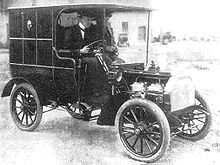
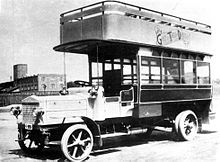
- Timeline
- 1889 the firstfour-strokegas engine was built by the Ganz factory
- 1893 the manufacture ofparaffinandpetrolfuelled engine withcarburetor
- 1898 the manufacture of engines with the Bánki water injection system
- 1908 the introduction of a newpetrol enginetype, the series Am
- 1913 the manufacture ofBüssingpetrol engines fortrucks
- 1914–18 the manufacture offighter plane engines
- 1916 the manufacture of petrol engines, type Fiat
- 1920 the modification of petrol engines forsuction gasoperation
- 1924György Jendrassikstarted his engine development activity
- 1928 the first railwaydiesel enginewas completed, according to the plans of Ganz-Jendrassik
- 1929 the first export delivery of a railway engine using the system of Ganz-Jendrassik
- 1934 there was an engine reliability World Competition in the USSR where the Ganz engine achieved the best fuel consumption in its category
- 1939 Scale model of Ganz Ac Electric locomotive exhibited at the Italy Pavilion of the New York World's Fair
- 1939–42 construction of theJendrassik Cs-1turbopropengine
- 1944 the first application of the engine type XII JV 170/240 in a motor-train set
- 1953 modernisationon of the diesel engine system Ganz-Jendrassik
- 1959 the union of the Ganz factory and theMÁVAGcompany, establishing Ganz-MÁVAG
Railways
[edit]Steam motors
[edit]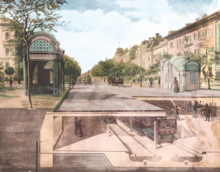
The Ganz Company started to constructsteam locomotivesandsteam railcarsfrom the 1860s. Between 1901 and 1908, Ganz Works of Budapest andde Dion-Boutonof Paris collaborated to build a number of railcars for the Hungarian State Railways together with units with de Dion-Bouton boilers, Ganz steam motors and equipments, and Raba carriages built by theRaba Hungarian Wagon and Machine FactoryinGyőr.In 1908, the Borzsavölgyi Gazdasági Vasút (BGV), anarrow-gauge railwayinCarpathian Ruthenia(today's Ukraine), purchased five railcars from Ganz and four railcars from the Hungarian Royal State Railway Machine Factory with de Dion-Bouton boilers. The Ganz company started to exportsteam motorrailcars to the United Kingdom, Italy, Canada, Japan, Russia and Bulgaria.[16][17][18]
The World's first electrified main railway line in Italy
[edit]The Ganz Works, having identified the significance ofinduction motorsandsynchronous motors,commissionedKálmán Kandóto develop them. In 1894, Hungarian engineer Kálmán Kandó developed high-voltagethree-phase AC motors and generatorsforelectric locomotives.The first-ever electric rail vehicle manufactured by Ganz Works was a 6 HP pit locomotive with direct current traction system. The first Ganz madeasynchronousrail vehicles (altogether 2 pieces) were supplied in 1898 toÉvian-les-Bains(France) with a 37 HP asynchronous traction system. The Ganz Works won the tender for electrification of theValtellinaRailway in Italy in 1897. Under the management, and on the basis of plans from Kálmán Kandó, three phase electric power at 3 kV and 15 Hz was fed through two upper wires and the rails.

The electricity was produced in a dedicated power station and the system operated for thirty years from 1902. Italian railways were the first in the world to introduce electric traction for the entire length of a main line rather than just a short stretch. The 106 km Valtellina line was opened on 4 September 1902, designed by Kandó and a team from the Ganz works.[19][20]The voltage was significantly higher than used earlier and it required new designs for electric motors and switching devices.[21][22]The three-phase two-wire system was used on several railways in Northern Italy and became known as "the Italian system". Kandó was invited in 1905 to undertake the management of Società Italiana Westinghouse and led the development of several Italian electric locomotives.[21]
Invention of the Phase Converter
[edit]In 1918,[23]Kandó invented and developed therotary phase converter,enabling electric locomotives to use three-phase motors whilst supplied via a single overhead wire, carrying the simple industrial frequency (50 Hz) single phase AC of the high-voltage national networks.[20] AfterWorld War I,at the Ganz Works, Kálmán Kandó constructed a single-phase electric railway system using 16 kV at 50 Hz. A similar system, but using15 kV at 16.7 Hz,later became widely used in Europe. The main attribute of Kandó's 50 Hz system was that it was fed by the normal power network, so dedicated railway power stations became unnecessary. Because of the early death of Kálmán Kandó,László Verebélÿcontinued the work for theHungarian State Railways(MÁV).[24]
- Ganz Rail rolling stock
-
The first steam railcar built by Ganz and de Dion-Bouton
-
Ganz AC electric locomotive prototype (1901Valtellina,Italy)
-
Electric locomotive RA 361 (laterFS Class E.360) by Ganz for the Valtellina line, 1904
-
The first locomotive with a phase converter was Kando's V50 locomotive (only for demonstration and testing purposes)
-
Árpád Diesel railbus in 1937
-
Ganz train on theFerrocarriles Patagónicosrailway in Argentina (1945)
-
A seriesV63Ganz-MÁVAGelectric locomotive of Hungarian State Railways
Ganz-MÁVAG rail rolling stock
[edit]
In 1959 Ganz merged with theMÁVAGcompany and was renamedGanz-MÁVAG. In 1976 Ganz-Mávag supplied tenstandard gauge3-car diesel trainset to theHellenic Railways Organisation(OSE), designated as Class AA-91 and fourmetre gauge4-car trainsets, designated as Class A-6451. In 1981/82 Ganz-Mávag supplied to OSE 11 B-B diesel-hydraulic DHM7-9 locomotives, designated as class A-251. Finally, in 1983, OSE bought eleven 3-car metre gauge trainsets, designated as Class A-6461. All these locomotives and trainsets have been withdrawn with the exception of one standard and one metre gauge trainset.[citation needed]
In 1982/83 Ganz-Mávag supplied an order forelectric multiple unitstoNew Zealand Railways Corporationfor Wellington suburban services. The order was made in 1979, and was for 44 powered units and 44 trailer units, seeNew Zealand EM class electric multiple unit.[citation needed]
Ganz-MÁVAG Trams
[edit]Ganz-MÁVAGdelivered 29 trams (2 car sets) toAlexandria, Egyptfrom 1985 to 1986.[25]
Shipbuilding, Ganz - Danubius
[edit]In 1911, the Ganz Company merged with theDanubius shipbuilding company,which was the largest shipbuilding company in Hungary. From 1911, the unified company adopted the"Ganz–Danubius"brand name. In the beginning of the 20th century the company had 19 shipyards on the Danube and the Adriatic Sea in the city of Rijeka and Pula.[26] As Ganz Danubius, the company became involved in shipbuilding before, and during,World War I.Ganz was responsible for building the dreadnoughtSMSSzent István,all of theNovara-class cruisers,and built diesel-electricU-boatsat its shipyard in Budapest, for final assembly atFiume.Several U-boats of theU-XXIX class,U-XXX class,U-XXXI classandU-XXXII classwere completed,[27]A number of other types were laid down, but remained incomplete at the war's end.[28]By the end of the First World War, 116 naval vessels had been built by The Ganz-Danubius company. The company also produces transatlantic ocean liners for passenger lines Trieste - New York, Trieste - Montevideo, as a reflection of already formed wave of mass migration from Central Europe to America.
- Ganz–Danubiusships and submarines
-
The battle-damagedSMSNovara(1913)after a victoriousnaval battle
-
Aircraft
[edit]The first Hungarian "aeroplane factory" (UFAG) was founded by the Ganz Company andWeiss-ManfrédWorks in 1912. During World War I, the company made many types ofAlbatrosandFokkerfighter planes.
Before 1919, the company builtocean liners,dreadnoughttypebattleshipsandsubmarines,power plants,automobiles[29][30]and many types of fighter aircraft.[31]
The world's firstturbopropengine was theJendrassik Cs-1designed by the Hungarian mechanical engineerGyörgy Jendrassik.It was built and tested in the Ganz factory in Budapest between 1939 and 1942. It was planned to be fitted to the Varga RMI-1 X/H twin-engined reconnaissance bomber designed by László Varga in 1940, but the program was cancelled. Jendrassik had also designed a small-scale 75 kW turboprop in 1937.[citation needed]
After World War II
[edit]In 1947, the Ganz Works was nationalised and in 1949 it became independent and six big companies came into existence, including the Ganz Transformer Factory. In 1959, Ganz Wagon and Machine Factory merged with theMÁVAGLocomotive and Machine Factory under the name of Ganz-MÁVAG Locomotive, Wagon and Machine Works. Of the products of the Works, outstanding results were shown in the field of the manufacture ofdiesel railcarsandmultiple units.Traditional products includedtramcarsas well, and customers included the tramway network of Budapest. In the meantime the Foundry workshop was closed down.
In 1974, the locomotive and wagon Works were merged under the name of Railway Vehicle Factory and then the machine construction branch went through significant development. The production of industrial and apartment houseliftsbecame a new branch. Ganz-MÁVAG took over a lot of smaller plants in the 1960s and 1970s and their product range was extended. Among other things, they increased their bridge-building capacity. They made iron structures for severalTiszabridges, for theErzsébet Bridgein Budapest, for public road bridges in Yugoslavia and for several industrial halls.
The Ganz Shipyard experienced its most productive times during the four decades following nationalisation. In the course of this period 1100 ship units were produced, the number of completed seagoing ships was 240 and that of floating cranes was 663. As a result of the great economic and social crises of the 1980s, Ganz-MÁVAG had to be reorganised. The company was transformed into seven independent Works and threejoint ventures.
Ganz since 1989
[edit]In 1989, the British company Telfos Holdings gained a majority of the shares in Ganz Railway Vehicle Factory Co. Ltd. and the name of the company was changed to Ganz-Hunslet Co. Ltd. In the course of 1991 and 1992, the Austrian companyJenbacher Werkeobtained 100% of the company's shares and consequently the railway vehicle factory is now a member of the international railway vehicle manufacturing group, Jenbacher Transport Systeme. At present, the Ganz Electric Works, under the name of Ganz-Ansaldo is a member of the Italian industrial giant,AnsaldoBreda.The Ganz Works were transformed into holdings. Ganz-Danubius was wound up in 1994. The Ganz Electric Meter Factory in Gödöllő became the member of the international Schlumberger group.
In 2006, the power transmission and distribution sectors of Ganz Transelektro were acquired byCrompton Greaves,[32]but still doing business under the Ganz brand name, while the unit dealing with electric traction (propulsion and control systems for electric vehicles) was acquired byŠkoda Transportationand is now a part ofŠkoda Electric.[33]
Now the plant is operated by a new investor as a tenant, Ganz Transformer Motor and Manufacturing Ltd., after the previous owner was unable to finance the production.[34]
Timeline[35]
1991: Joint Venture with Italian Ansaldo named Ganz Ansaldo Ltd.
1994: Air-cooled turbogenerator from 20 up to 70MVA
1998: Development of double-cage induction motor for twin-drives first on the world
2000: Acquisition by Tranelektro Group under name of Ganz-Transelektro
2001: Developed 1MW ExN Non-sparking gasturbine starter motors for GE
2002: First transformer in the world for 123 kV with ester liquid
2006: Became a Part of Crompton Greaves Ltd as CG Electric Systerms Hungary
2010: Start of manufacturing Safety Class 3&4 motors for Nuclear Power Plants
2018: Developing VFD-driven Increased Safety LVAC motors for driving OEM pumps used in Oil&gas fields
2020: Establishment of Ganz Transformer Motor and Generator Ltd., Ganz brand back in Hungarian ownership
Divisions
[edit]Source:[36]
Transformer division[37]
The Transformer division specializes in the design, manufacture and testing of substation transformers, generation transformers, auxiliary transformers, mobile transformers and traction transformers from 20 to 600 MVA (1000 MVA for autotransformers) from 52 to 800 kV.
Rotating machines division[38]
The production of three-phase, alternating current induction motors began in the factory in 1894. Through the 90's Ganz has developed more advanced motors with decreased total weight, increased efficiency and low noise levels in order to satisfy the actual needs of the market and all conditions of the industrial application and to conform to IEC, NEMA, ATEX and EAC standards.
GIS Service Division[39]
GIS Service division performs onsite works like maintenance, inspection, modification, overhaul, extensions on former GANZ and other brands of switchgears. The activity is mainly focused on the existing substations and equipment.
References
[edit]- ^About usat Ganz Holding (19 Mar 2023)
- ^About us,Ganz-holding.hu
- ^Mikulas Teich; Roy Porter; Bo Gustafsson (1996).The Industrial Revolution in National Context: Europe and the USA.Cambridge University Press.p. 280.ISBN9780521409407.
- ^Guarnieri, M. (2013). "Who Invented the Transformer?".IEEE Industrial Electronics Magazine.7(4): 56–59.doi:10.1109/MIE.2013.2283834.S2CID27936000.
- ^Hughes, Thomas P. (1993).Networks of Power: Electrification in Western Society, 1880-1930.Baltimore: The Johns Hopkins University Press. pp. 95–96.ISBN978-0-8018-2873-7.RetrievedSep 9,2009.
- ^http:// sze.hu/~mgergo/EnergiatudatosEpulettervezes/2013_1_feladat/ErosErika/V%EDzenergia%20hasznos%EDt%E1s%20szigetk%F6zi%20szemmel%20EL%D5AD%C1SANYAG.pdf[permanent dead link]
- ^American Society for Engineering Education(1995).Proceedings, Part 2.p. 1848.
- ^Robert L. Libbey (1991).A Handbook of Circuit Math for Technical Engineers.CRC Press. p. 22.ISBN9780849374005.
- ^"Bláthy, Ottó Titusz".Retrieved20 December2016.
- ^Electrical Society of Cornell University (1896).Proceedings of the Electrical Society of Cornell University.Andrus & Church. p. 39.
- ^"Ottó Bláthy, Miksa Déri, Károly Zipernowsky".IEC Techline. Archived fromthe originalon September 30, 2007.RetrievedApr 16,2010.
- ^Hungarian Inventors and their InventionsArchived2012-03-22 at theWayback Machine
- ^Eugenii Katz."Blathy".Clarkson University. Archived fromthe originalon June 25, 2008.Retrieved2009-08-04.
- ^The development and heyday of mechanical science (Hungarian) Link
- ^The development and heyday of mechanical science (Hungarian) Link
- ^Railroad Gazette – Volume 37 – Page 296 (printed in 1904)
- ^Modern Machinery – Volumes 19–20 – Page 206 (Printed in 1906)
- ^John Robertson Dunlap,Arthur Van Vlissingen,John Michael Carmody:Factory and Industrial Management – Volume 33 – Page 1003 (printed in 1907
- ^Duffy (2003),p. 120-121.
- ^abHungarian Patent Office."Kálmán Kandó (1869–1931)".mszh.hu. Archived fromthe originalon 2010-10-08.Retrieved2008-08-10.
- ^ab"Kalman Kando".Retrieved2011-10-26.
- ^"Kalman Kando".Archived fromthe originalon 2012-07-12.Retrieved2009-12-05.
- ^Duffy, Michael C. (2003).Electric Railways 1880–1990.IET.p. 137.ISBN9780852968055.
- ^"Ganz and Tungsram – the 20th century".Electric History.EnergoSolar. 2007. Archived fromthe originalon 6 January 2009.Retrieved20 December2016.
- ^"Archived copy"(PDF).Archived fromthe original(PDF)on 2015-01-10.Retrieved2015-01-10.
{{cite web}}:CS1 maint: archived copy as title (link) - ^History of Ganz Danubius
- ^R.H. Gibson, Maurice Prendergast (2002).The German Submarine War 1914–1918.Periscope Publishing Ltd. p. 386.ISBN9781904381082.
- ^http:// gwpda.org/naval/ahsubs.htmSieche article on KuK U-Boats
- ^Iván Boldizsár: NHQ; theNew Hungarian Quarterly,Volume 16, Issue 2; Volume 16, Issues 59–60, p. 128
- ^Hungarian Technical Abstracts: Magyar Műszaki Lapszemle, Volumes 10–13, p. 41
- ^Iván T. Berend:Case Studies on Modern European Economy: Entrepreneurship, Inventions, and Institutions,p. 151
- ^Ganz is now CGArchived2011-03-10 at theWayback MachineRetrieved 2009-11-28.
- ^[email protected], Lundegaard – e-business solutions provider, lundegaard.cz."Česká verze – ŠKODA TRANSPORTATION a.s."Archived fromthe originalon 13 April 2008.Retrieved20 December2016.
{{cite web}}:|first=has generic name (help)CS1 maint: multiple names: authors list (link) - ^"Production resumes at the Ganz factory – Ganz Group".8 September 2020.Retrieved2021-03-23.
- ^"About us – Ganz Group".Retrieved2021-03-23.
- ^"Ganz Group".Retrieved2021-03-23.
- ^"Transformer Division – Ganz Group".Retrieved2021-03-23.
- ^"Rotating Machines Division – Ganz Group".Retrieved2021-03-23.
- ^"GIS Service Division – Ganz Group".Retrieved2021-03-23.
External links
[edit]- Official website
 – Ganz Machinery Works Holding, current company
– Ganz Machinery Works Holding, current company - A photo of a Ganz railcar of Hungarian State Railways c1936
- A withdrawn Ganz-Mavag DMU at Mendoza, Argentina
- Ganz Transelektro Ltd's page in EnglishArchived2011-03-10 at theWayback Machine
- Ganz Danubius homepage
- Ganz Works
- Rolling stock manufacturers of Hungary
- Hungarian brands
- Tram manufacturers
- Companies of Austria-Hungary
- Motor vehicle manufacturers of Austria-Hungary
- Shipbuilding companies of Austria-Hungary
- Manufacturing companies established in 1844
- 1844 establishments in the Austrian Empire
- Electrical engineering companies
- Avantha Group




